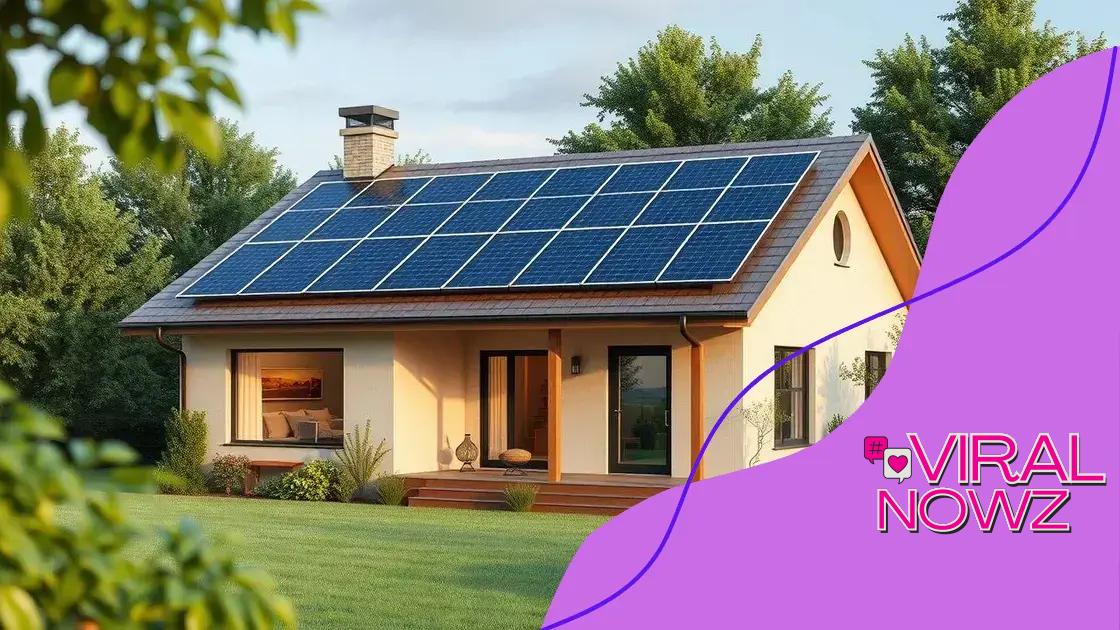Renewable energy incentives and rebates for homeowners

Renewable energy incentives and rebates for homeowners significantly reduce installation costs and lower utility bills, offering financial benefits through tax credits and various programs tailored to encourage clean energy adoption.
Renewable energy incentives and rebates for homeowners represent a unique opportunity to save on energy costs while contributing to a sustainable future. Have you ever wondered how these programs work and if they can truly benefit you? Let’s dive in and explore the possibilities!
Understanding renewable energy incentives
Understanding renewable energy incentives is crucial for homeowners looking to save money and contribute to environmental sustainability. These incentives can significantly offset the costs involved in switching to renewable energy sources, such as solar or wind power.
What Are Renewable Energy Incentives?
Renewable energy incentives are programs or policies designed to encourage the adoption of renewable energy technologies. They come in various forms, including tax credits, rebates, and grants. By taking advantage of these incentives, homeowners can lower their investment in energy-efficient upgrades.
Types of Incentives Available
- Tax Credits: Many states and the federal government offer tax credits for installing renewable energy systems. These can dramatically reduce your tax bill.
- Cash Rebates: Some utility companies provide cash rebates when you install renewable energy systems. This can help recoup your initial costs quickly.
- Low-Interest Loans: Financing options with lower interest rates are available for those investing in renewable technologies.
- Grants: Various organizations offer grants to homeowners for renewable energy projects, reducing overall expenses.
Understanding the specific incentives available to you can make a substantial difference in your decision to go green. For example, certain regions may have additional local programs that complement state and federal incentives. Before making any commitments, it’s wise to investigate all options.
The process can seem overwhelming, but numerous resources are available to help you navigate through them. Websites like the Database of State Incentives for Renewables & Efficiency (DSIRE) provide comprehensive information on state and federal incentives. They can guide you in selecting the best programs that fit your needs.
As you explore these opportunities, keep in mind that incentive programs may change over time. Staying updated on any new developments or renewals is key to maximizing your benefits. Therefore, regularly check the relevant sources and consult experts.
Types of rebates available for homeowners
Many homeowners are unaware of the various types of rebates available to them when they invest in renewable energy projects. These rebates can significantly lower your overall costs and make switching to clean energy more accessible.
Common Types of Rebates
Utility rebates are typically offered by local utility companies to encourage energy efficiency. By utilizing energy-efficient appliances or solar energy systems, homeowners can receive direct cash rebates. These rebates often depend on the type of system installed and can cover a substantial portion of installation costs.
Federal and State Rebates
In addition to utility rebates, there are federal and state-specific programs that provide financial incentives. For example, the federal government sometimes offers tax credits for renewable energy systems. Homeowners can claim a percentage of their installation expenses on their taxes, making the investment more affordable.
- Federal Tax Credit: Homeowners can reduce their federal tax bill by a percentage of their solar installation costs.
- Energy Efficiency Program Rebates: Many states have programs that provide rebates for energy-efficient upgrades.
- Local Grants: Occasionally, local governments offer grants for renewable energy installations to promote sustainability.
- Low-Interest Loans: These loans assist homeowners in financing energy-efficient upgrades at a lower cost.
Homeowners should research local options, as some communities may have unique programs tailored to their residents. It is also beneficial to connect with local energy experts who can provide guidance on maximizing these financial incentives.
Moreover, some environmental nonprofits offer additional resources and rebates for homeowners adopting green practices. By staying informed, you can ensure you take full advantage of available incentive programs.
How to apply for renewable energy rebates

Applying for renewable energy rebates can seem daunting, but the process can be straightforward if you follow a few key steps. Getting started is the first step towards saving money and promoting sustainability.
Research Available Rebates
Begin by researching the different rebates available in your area. Check with your local utility companies, as well as state and federal programs. Websites like the Database of State Incentives for Renewables & Efficiency (DSIRE) provide comprehensive information on available rebates. This can help you find the specific programs that suit your needs.
Gather Required Documentation
Once you know which rebates you’re interested in, collect the necessary documentation. This often includes proof of purchase, installation receipts, and any specific application forms required by the program. Make sure to keep copies of everything you submit to maintain a clear record.
- Proof of Installation: Many rebates require documentation from a certified installer to ensure the work meets local codes.
- Application Forms: Each rebate will have its own application. Fill it out carefully, as errors can delay your rebate.
- Tax Documents: If claiming a tax credit, keep copies of your tax returns to support your claim.
After gathering the necessary information, submit your application according to the program guidelines. Pay attention to deadlines—some rebates are only available for a limited time or have specific cut-off dates.
Next, follow up on your application. If you do not receive confirmation within a reasonable timeframe, contact the rebate program’s customer service to check the status. They can provide updates and help resolve any issues that may arise.
Finally, remember to stay informed about any updates or changes to the rebate programs. Following the latest news will help you take advantage of additional opportunities to save.
Financial benefits of switching to renewable energy
Switching to renewable energy offers homeowners several significant financial benefits. Understanding these advantages is crucial for making informed decisions about energy options.
Lower Utility Bills
One of the most immediate benefits of using renewable energy sources, such as solar or wind power, is the reduction in monthly utility bills. By generating your own electricity, you can lower your dependence on your utility provider and potentially eliminate your electric bill entirely.
Increased Property Value
Installing renewable energy systems can increase the value of your home. Many homebuyers consider energy efficiency a plus. Homes with solar panels or other renewable options often sell for more than comparable homes without such systems. This increase in property value makes investing in renewable energy a smart financial move.
- Tax Incentives: Homeowners may qualify for tax credits or deductions, further lowering the cost of renewable energy installations.
- Financing Options: Many banks and credit unions offer loans with favorable terms specifically for renewable energy projects, making it easier for homeowners to afford these upgrades.
- Long-Term Savings: Over time, the savings from lower energy bills and tax incentives can significantly outweigh the initial costs of renewable energy installations.
Moreover, many renewable energy systems require minimal maintenance compared to traditional energy sources, which can lead to additional savings. For example, solar panels often only require an occasional cleaning and inspection, while gas or oil furnaces can incur ongoing repair costs.
As energy prices continue to rise, investing in renewable energy becomes increasingly appealing. You leverage the opportunity to protect yourself against these rising costs, as your renewable energy system will provide stable energy prices over its lifespan. Homes equipped with renewable energy solutions are likely to enjoy long-term financial stability.
Common misconceptions about renewable energy incentives
Many homeowners have misconceptions about renewable energy incentives that can prevent them from taking advantage of available benefits. Understanding the facts can help clarify the situation and encourage more people to consider renewable energy options.
Misperception: Renewable Energy Is Too Expensive
One common belief is that switching to renewable energy systems, like solar panels, is prohibitively expensive. In reality, there are numerous incentives that can significantly lower initial costs. Many states offer generous rebates, and federal tax credits further reduce expenses. Additionally, financing options allow homeowners to pay for systems over time.
Misperception: Incentives Are Limited
Another misconception is that incentives are only available in certain areas or for specific technologies. While some programs may vary by location, many rebates and incentives are available in most regions. It’s essential to do thorough research and consult local resources to find available programs that fit your needs.
- Local Utility Programs: Almost all utility companies offer some form of incentives or rebates for energy-efficient upgrades.
- State Programs: Many states have dedicated programs aimed at promoting renewable energy.
- Federal Incentives: Still available, these incentives are often overlooked but can provide substantial savings.
Additionally, people often believe they will not qualify for any rebates. Many incentives do not have strict eligibility requirements, making them accessible to a wider audience. Homeowners should carefully review the criteria to see if they qualify for various programs.
Moreover, some individuals think that renewable energy systems require extensive maintenance. While these systems do need occasional upkeep, they are typically designed for long-term use and require less maintenance than traditional systems. For instance, solar panels usually need only a cleaning once or twice a year.
FAQ – Frequently Asked Questions about Renewable Energy Incentives
What types of renewable energy incentives are available?
There are various incentives, including tax credits, cash rebates, and low-interest loans offered by local utilities and governments.
How can I apply for renewable energy rebates?
To apply, you need to research available rebates, gather the required documentation, and submit an application through the respective program.
Will switching to renewable energy save me money?
Yes! By utilizing renewable energy, homeowners can significantly reduce their utility bills and benefit from tax incentives.
Are there any common misconceptions about renewable energy incentives?
Many people think incentives are only for specific technologies or that they are too expensive. In reality, incentives are widely available and can lower initial costs significantly.





